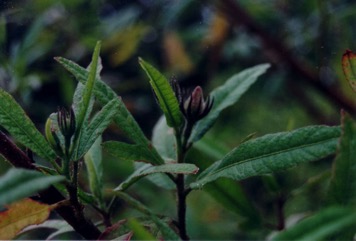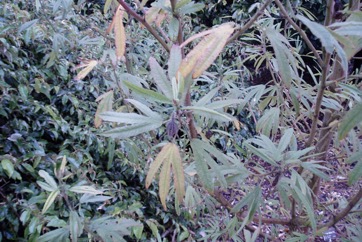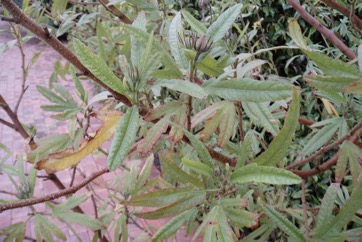Yellow Hibiscus, Prickly tree hibiscus

It grows in warm temperate regions and can grow in the subtropics. It grows in damp places along rivers and near the edges of lakes. The soil needs to be well drained but wet. It can stand light frosts. In Tanzania it grows from sea level to 1,800 m above sea level. It grows in areas with a rainfall between 1,400-2,100 mm. It grows well in deep clay soils with permanent moisture. It suits hardiness zones 10-12. Adelaide Botanical Gardens.
Also known as:
Chatata, Hibisco-do-banhado, Ihirene, Khuluza, Malakwang, Muhangana, Muvava, Native Hibiscus, Swamp hibiscus
Synonyms
- Hibiscus macularis E. Meyer
- Hibiscus ficulneus sensu Cav.
Edible Portion
- Flowers, Leaves, Root, Vegetable, Seeds
Where does Yellow Hibiscus grow?
Found in: Africa, Angola, Australia, Botswana, Brazil, Burkina Faso, Central Africa, East Africa, Ethiopia, Fiji, Madagascar, Malawi, Mauritius, Mozambique, Myanmar, New Caledonia, New Zealand, Norfolk Island, Pacific, Papua New Guinea, PNG, Rwanda, South Africa, Southern Africa, South America, St Helena, Sudan, Tanzania, Uganda, Zambia, Zimbabwe
Notes: There are about 220 Hibiscus species.
Status: It is not popular but used during famines and when other vegetables are in short supply.
Growing Yellow Hibiscus, Prickly tree hibiscus
Cultivation: Plants can be grown from seed or cuttings.
Edible Uses: The flowers are cooked and eaten. The leaves may have to be used with caution. They are bitter and sour. They are wilted in the sun then chopped and cooked.
Production: Leaves are collected from swamps in the dry season.
Nutrition Info
per 100g edible portion| Edible Part | Energy (kcal) | Protein (g) | Iron (mg) | Vitamin A (ug) | Vitamin c (mg) | Zinc (mg) | % Water |
|---|---|---|---|---|---|---|---|
| Flower | 26 | 0.4 | 2.5 | - | - | 0.5 | 81.1 |
| Leaves | - | - | - | - | - | - |
Yellow Hibiscus, Prickly tree hibiscus Photos



References
Acipa, A. et al, 2013, Nutritional Profile of some Selected Food Plants of Otwal and Ngai Counties, Oyam District, Northern Uganda. African Journal or Food, Agriculture, Nutrition and Development. 13(2)
Andabati, B., & Muyonga, J., 2014, Phenolic content and antioxidant activity of selected Ugandian traditional medicinal foods. African Journal of Food Science. 8(8), pp 427-434
Bodkin, F., 1991, Encyclopedia Botanica. Cornstalk publishing, p 557
Collectanea 2:307. 1789 ("1788"); Icon. pl. rar. 3: t. 551. 1792 ("1786-1793")
Cooper, W. and Cooper, W., 2004, Fruits of the Australian Tropical Rainforest. Nokomis Editions, Victoria, Australia. p 277
Cronin, L., 1989, The Concise Australian Flora. Reed. p 94
Cundall, P., (ed.), 2004, Gardening Australia: flora: the gardener's bible. ABC Books. p 701
Elliot, W.R., & Jones, D.L., 1990, Encyclopedia of Australian Plants suitable for cultivation. Vol 5. Lothian. p 356
Etherington, K., & Imwold, D., (Eds), 2001, Botanica's Trees & Shrubs. The illustrated A-Z of over 8500 trees and shrubs. Random House, Australia. p 378
Flora of Australia Volume 49, Oceanic Islands 1, Australian Government Publishing Service, Canberra. (1994) p 116
Fowler, D. G., 2007, Zambian Plants: Their Vernacular Names and Uses. Kew. p 45
Fox, F. W. & Young, M. E. N., 1982, Food from the Veld. Delta Books. p 262
Franklin, J., Keppel, G., & Whistler, W., 2008, The vegetation and flora of Lakeba, Nayau and Aiwa Islands, Central Lau Group, Fiji. Micronesica 40(1/2): 169–225, 2008
Grubben, G. J. H. and Denton, O. A. (eds), 2004, Plant Resources of Tropical Africa 2. Vegetables. PROTA, Wageningen, Netherlands. p 562
Hussey, B.M.J., Keighery, G.J., Cousens, R.D., Dodd, J., Lloyd, S.G., 1997, Western Weeds. A guide to the weeds of Western Australia. Plant Protection Society of Western Australia. p 174
INFOODSUpdatedFGU-list.xls
Jardin, C., 1970, List of Foods Used In Africa, FAO Nutrition Information Document Series No 2.p 81
Kinupp, V. F., 2007, Plantas alimenticias nao-convencionais da regiao metropolitana de Porto Alegre, RS, Brazil p 81
Kinupp, V. F. & Bergman, I., 2008, Protein and minerals of native species, potential vegetables and fruits. Cienc.Tecnol. Aliment. Vol. 28 No. 4 Campinas Oct/Dec.
Lim, T. K., 2015, Edible Medicinal and Non Medicinal Plants. Volume 9, Modified Stems, Roots, Bulbs. Springer p 46
Lord, E.E., & Willis, J.H., 1999, Shrubs and Trees for Australian gardens. Lothian. p 175
Matthews, J., 1987, New Zealand Native Plants for your Garden. Pacific Publishers, p 58
Melzer, R. & Plumb, J., 2011, Plants of Capricornia. Belgamba, Rockhampton. p 169
Molyneux, B. and Forrester, S., 1997, The Austraflora A-Z of Australian Plants. Reed. p 123
Paczkowska, G. & Chapman, A.R., 2000, The Western Australian Flora. A Descriptive Catalogue. Western Australian Herbarium. p 289
Palgrave, K.C., 1996, Trees of Southern Africa. Struik Publishers. p 584
Peters, C. R., O'Brien, E. M., and Drummond, R.B., 1992, Edible Wild plants of Sub-saharan Africa. Kew. p 144
Plants for a Future database, The Field, Penpol, Lostwithiel, Cornwall, PL22 0NG, UK. http://www.scs.leeds.ac.uk/pfaf/
Recher, P, 2001, Fruit Spirit Botanical Gardens Plant Index. www.nrg.com.au/~recher/ seedlist.html p 6
Ruffo, C. K., Birnie, A. & Tengnas, B., 2002, Edible Wild Plants of Tanzania. RELMA p 376
Ruiters-Welcome, A. K., 2019, Food plants of southern Africa. Ph.D. thesis. Univ. of Johannesburg p 76
Ryan, M. (Ed.), 2003, Wild Plants of Greater Brisbane. Queensland Museum. p 175
Smith, A.C., 1981, Flora Vitiensis Nova, Lawaii, Kuai, Hawaii, Volume 2 p 419
Williamson, J., 2005, Useful Plants of Malawi. 3rd. Edition. Mdadzi Book Trust. p 132
World Checklist of Useful Plant Species 2020. Royal Botanic Gardens, Kew